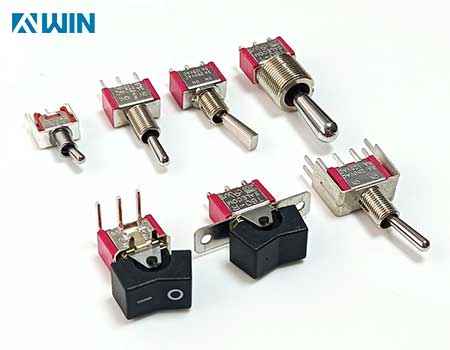Selecting the right toggle switch involves considering various factors to ensure compatibility with the application's requirements. Here's a toggle switches selection guide:

1. Switch Type:
Choose the appropriate switch type based on the application:
Single Pole Single Throw (SPST): Controls one circuit with one ON/OFF position.
Single Pole Double Throw (SPDT): Controls one circuit, but has two ON positions.
Double Pole Single Throw (DPST): Controls two circuits simultaneously with one ON/OFF position.
Double Pole Double Throw (DPDT): Controls two circuits with two ON positions.
2. Current and Voltage Ratings:Ensure that the switch is rated for the electrical load it will be controlling. Consider both current and voltage requirements.
3. Panel Mounting:Determine if the toggle switch needs to be panel-mounted. Some switches are designed for surface mounting, while others require a hole in the panel.
4. Number of Positions:Decide on the number of positions needed (e.g., 2-position, 3-position, 4-position). Consider momentary options if applicable.
5. Momentary vs. Maintained:Decide whether a momentary or maintained action is required. Momentary switches return to their default position when released, while maintained switches stay in the selected position.
6. Locking Mechanism:For applications where the switch needs to stay in a particular position, consider switches with locking mechanisms.
7. Environmental Considerations:In harsh environments, consider switches with features like sealing against dust and moisture. Check the IP (Ingress Protection) rating.
8. Termination Type:
Choose the appropriate termination type based on the application:
Solder Lugs: For soldering wires directly to the switch.
Screw Terminals: Provide a more secure connection using screws.
9. Size and Form Factor:Consider the physical size of the switch to ensure it fits within the available space on the panel or device.
10. Illumination:Decide if illumination is needed. Illuminated toggle switches have a built-in light, often LED, to indicate the switch's status.
11. Color and Markings:Choose a switch with clear markings or color-coding for easy identification of positions.
12. Compliance and Certifications:Ensure that the toggle switch complies with relevant industry standards and certifications.
13. Application-Specific Features:Consider any application-specific features required, such as high-temperature resistance, corrosion resistance, or specific actuator styles.
14. Budget:Consider the budget constraints and select a switch that meets the required specifications within the budget.
15. Manufacturer Reputation:Choose toggle switches from reputable manufacturers known for quality and reliability.
Before finalizing the selection, review the manufacturer's datasheets and specifications to ensure that the chosen toggle switch meets all the necessary requirements for the specific application. Testing and prototyping may also be beneficial to ensure compatibility.
Contact: Ms Bella
Phone: +86-15999819066
Tel: +86-0769-89615395
Email: Bella@fvwin.com
Add: No 25, Xinfeng East Road, Shijie Town, Dongguan, GD, CN, 523000
We chat
